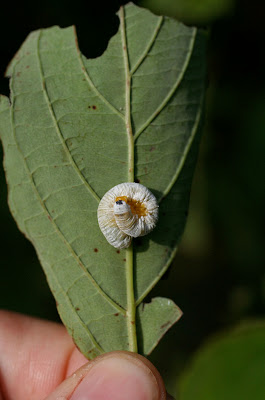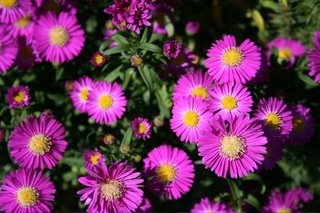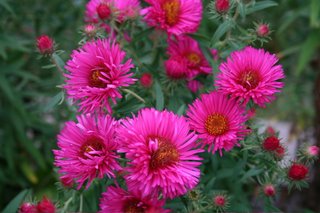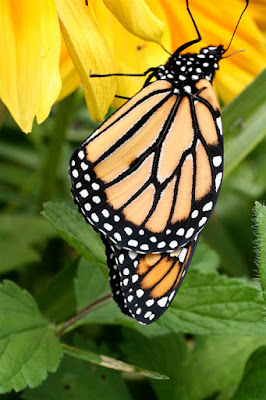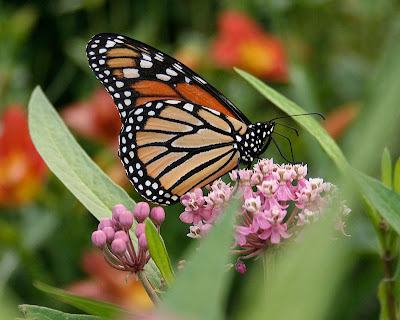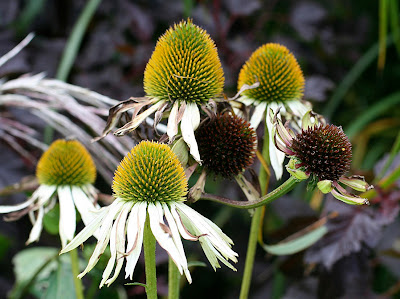
I've been working on a couple of assignments that mention seedheads, berries, and other fruit forms, and that necessitated me taking a walk around the yard with my camera, looking to see what has or is in the process of setting seed. I'm not the tidiest of gardeners, and while I deadhead my container plantings, I tend to leave the perennial beds alone so that they can set seed to provide food for birds and winter interest for me.

Teasels are a mixed blessing. On the one hand, their seedheads look marvelous all winter long, especially if sheathed in ice or dusted with snow, and their seeds feed a number of songbirds. On the other hand, you need to mulch heavily under them or be prepared to dig up about 90,000 seedlings per plant next spring.

One of my favourite native plants is the witherod, or wild raisin (Viburnum nudum var cassinoides). It grows in the woods around our place but I actually planted several shrubs in our garden last year so as to encourage their spread a little more.
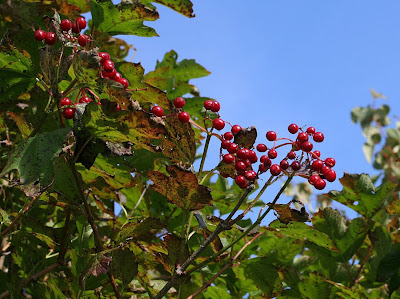
We have a big highbush cranberry (Viburnum trilobum) in the back garden, and it has a good crop of fruit at the moment. I expect visiting waxwings and other fruit-eaters will take care of that in coming weeks and months.

This is going to be 'quite a year for rose hips' if the rugosas are any indication.

However, they're still flowering as well as setting fruit, which makes me very happy, as the rugosas are one of my garden favourites.
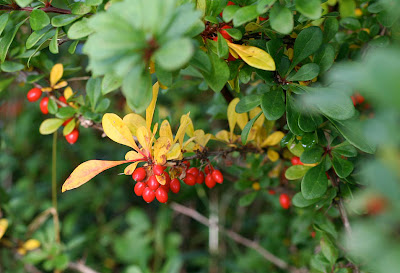 Another garden favourite are the Japanese barberries, of which we have a number. The best one for fall display is the standard green one. The foliage turns awesome shades of gold, carmine, and scarlet, and the brilliant red berries look stunning against that backdrop.
Another garden favourite are the Japanese barberries, of which we have a number. The best one for fall display is the standard green one. The foliage turns awesome shades of gold, carmine, and scarlet, and the brilliant red berries look stunning against that backdrop.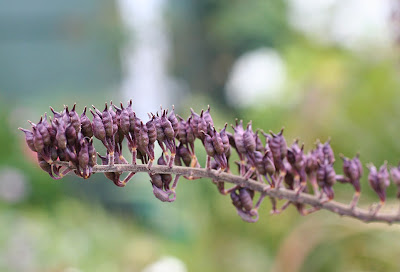 Whether you call it Cimicifuga or Actaea, black cohosh is a splendid perennial. Ours are just finishing up their flowering and are forming very cool seedheads, which look neat in flower arrangements as well as waving in the autumn breezes.
Whether you call it Cimicifuga or Actaea, black cohosh is a splendid perennial. Ours are just finishing up their flowering and are forming very cool seedheads, which look neat in flower arrangements as well as waving in the autumn breezes. Some of the clematis have finished up flowering and have gone to seed, with these pompom like tassels all but covering the vines.
Some of the clematis have finished up flowering and have gone to seed, with these pompom like tassels all but covering the vines.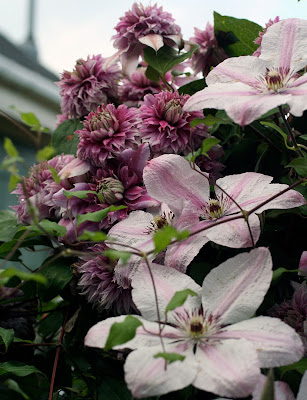
Others continue to flower. This is 'Josephine', a personal favourite because it blooms for a long long time and also manages to have both double and single flowers.
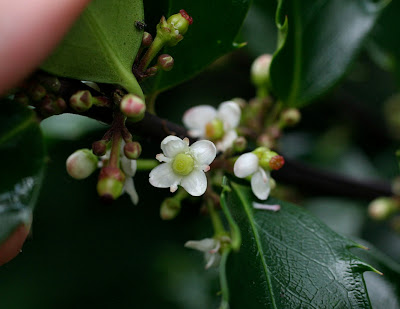
I don't expect to have much for holly berries this year, either in the evergreen or in our winterberries. The male evergreen holly decided to have a traumatic winter and lost every leaf, the first time it's done that in the ten years I've had it. I cut it way back and it's rallying, but not flowering. The female, on the other hand, is more than eight feet tall in some spots, and is still flowering, hoping to catch some pollen somewhere. One of my male winterberries had an unfortunate winter, getting broken down to the ground, and the other isn't very big yet, so I don't know that it produced enough pollen for any of the plants to get fertilized. I guess we'll know in a few more weeks.
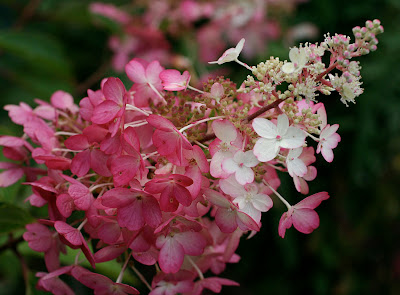 I was sent this Paniculata hydrangea to trial along with a few others several years ago. Unfortunately, the label got lost somewhere in transit and I have no idea which one this is. It might be 'Pinky Winky' because it keeps producing flowers from the tips, but I don't think it had that name when I got it. Whatever it is, it's fabulous, though not as early flowering or fast-growing as 'Quick Fire.'
I was sent this Paniculata hydrangea to trial along with a few others several years ago. Unfortunately, the label got lost somewhere in transit and I have no idea which one this is. It might be 'Pinky Winky' because it keeps producing flowers from the tips, but I don't think it had that name when I got it. Whatever it is, it's fabulous, though not as early flowering or fast-growing as 'Quick Fire.'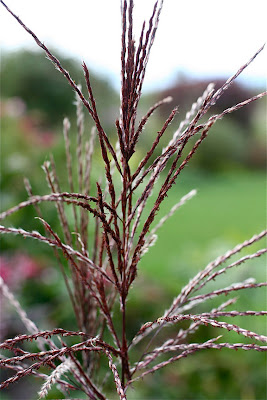 My miscanthus varieties are all blooming now, with my favourite being Martin Quinn's 'Huron Sunrise.' You have to watch out for miscanthus because some spread by runners while others form well-behaved clumps. This is a clump-former.
My miscanthus varieties are all blooming now, with my favourite being Martin Quinn's 'Huron Sunrise.' You have to watch out for miscanthus because some spread by runners while others form well-behaved clumps. This is a clump-former.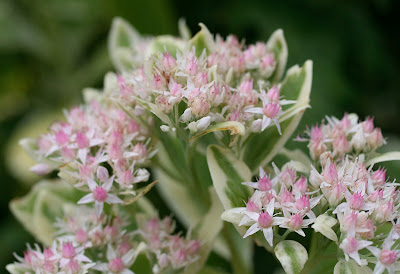 There are still plenty of things flowering in the garden, although they're quite far-flung around the yard, unlike in high summer when there are blooms everywhere we look.
There are still plenty of things flowering in the garden, although they're quite far-flung around the yard, unlike in high summer when there are blooms everywhere we look.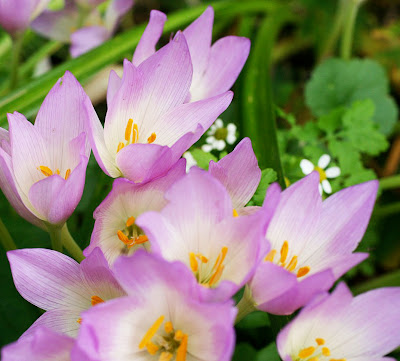
Every autumn, the colchicum surprise me with their sudden blooms. They leaf out in the spring, the foliage dies back, and I forget about them until they explode into blossom in mid-September. It's nice to have an autumn surprise like this, and I'd welcome more of this type of surprise. As opposed to the one that will happen one of these days when we get surprised by frost. Hopefully we're still some time from that, though. Yes, I'm still in autumn 'de nile' but only a little.


